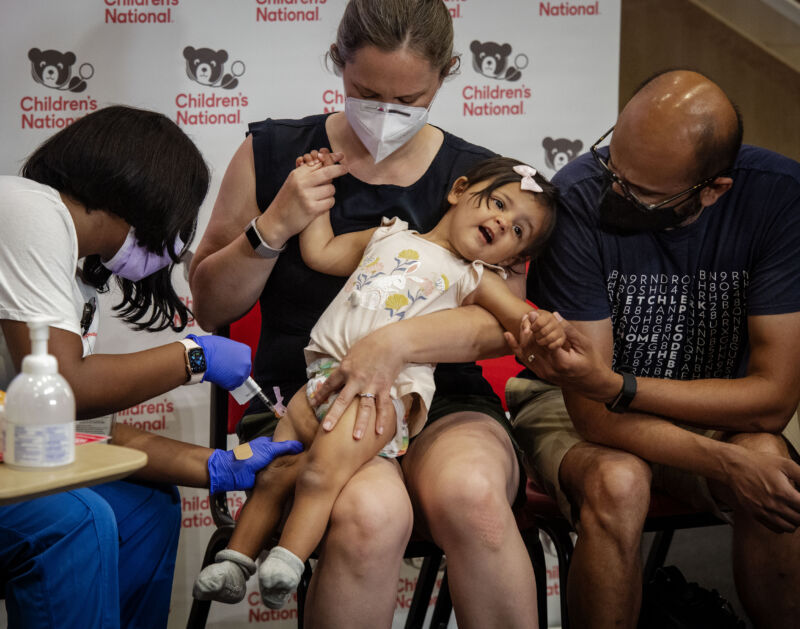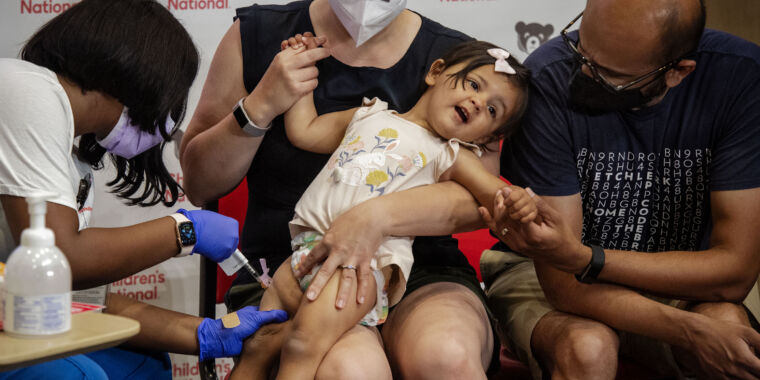
The Food and Drug Administration has given the green light to updated COVID-19 vaccine doses for children under age 5, but the change in approved vaccination schedules is far from easy. This could further hamper efforts to vaccinate the youngest Americans, which have already got off to a disastrous start.
After months of availability, only about 3 percent of babies and toddlers ages 6 months to 2 years have completed a primary series. Only 6.5 percent have received at least one injection, according to data from the Centers for Disease Control and Prevention. For those ages 2 to 4, just under 5 percent have completed a primary series, with 9 percent receiving at least one dose.
It was in June when the FDA approved small doses of both Moderna’s and Pfizer’s COVID-19 vaccines — and the CDC approved — for children as young as 6 months old.
- For Moderna’s vaccine, infants from 6 months to adolescents aged 17 can receive a primary series two doses, one month apart.
- For Pfizer’s vaccine, babies from 6 months to children up to and including 4 years old can receive a primary series three doses, with the second given three weeks after the first and the third at least eight weeks after the second. (Pfizer’s vaccine was previously available for children ages 5 and older.)
This fall, the FDA approved an “updated” bivalent vaccine for use as a booster dose in people ages 5 and older. The bivalent shot targets both the original version of SARS-CoV-2 and the coronavirus omicron subvariants BA.4/5, which were dominant during the summer months. Now BA.5 genetic offshoots dominate the circulation. Recent real-world effectiveness data suggests that the bivalent booster provides up to 56 percent more protection against symptomatic COVID-19 infection than protection against the original boosters.
But until now, kids under 5 have been stuck with just the original primary series, no boosters or bivalent shots.
What’s new for young children
On Thursday, the FDA approved bivalent injections for children ages 6 months to 4 years old, and the CDC is expected to approve the authorization and open availability soon. But the authorizations are a bit complicated; it is not a blanket authorization for boosters in this age group.
Only children 6 months through 5 years of age who have received Moderna’s two-dose primary series are eligible to receive a single bivalent vaccine as a booster dose. That booster dose should be given at least two months after completion of the primary series.
Pfizer’s bivalent vaccine does not yet have a booster available for children under 5 years of age.
The FDA has updated Pfizer’s three-dose primary series to include the bivalent vaccine as the third injection in the series. That means any child aged 6 months to 4 years who has not been vaccinated and is starting a Pfizer series or has already started a three-dose Pfizer series but has not yet completed it can receive the bivalent dose if their third dose in the Pfizer three-dose primary series. For example, if a 2-year-old has already received two Pfizer doses and is in the two-month period before their third injection, that toddler will receive the bivalent injection as their third dose when the time comes. Similarly, any child now starting the three-dose Pfizer series will end up with a bivalent injection as their third dose.
But for all children under the age of 5 who have already completed the original three-dose Pfizer series, this week’s update is not eligible for a bivalent injection or booster. However, the FDA said a bivalent booster could come for this group early next year.
“Children in this age group who have already completed their education [three-dose Pfizer] the primary series are still expected to protect against the most serious consequences of the currently circulating Omicron variant,” the FDA said Thursday. “The data to support giving an updated bivalent booster dose to these children will be released in January expected. The agency is committed to evaluating that data as soon as possible.”
Vaccination coverage
The complicated nature of the update does not bode well for boosting adoption of bivalent shots for this young group, which has already seen low adoption. That’s despite signs of an increase in COVID-19 cases and hospitalizations, as well as a continued crush of seasonal respiratory illnesses, such as RSV and flu, overwhelming US hospitals and hitting young children especially hard.
This week’s update “won’t have much impact in the real world,” Peter Hotez, a professor of pediatrics and molecular virology and microbiology at Baylor College of Medicine, told the Washington Post Thursday. “It’s like arguing about how many angels can dance on the tip of a pin.”
But the FDA is still pushing for more protection for the youngest.
“More children now have the opportunity to refresh their protection against COVID-19 with a bivalent COVID-19 vaccine, and we encourage parents and carers of those who qualify to consider this, especially as we enter the holiday season. and winter months, where more time will be spent indoors,” FDA Commissioner Robert Califf said Thursday. vaccinations, the more benefit there will be to individuals, families and public health by helping to prevent serious illnesses, hospitalizations and deaths.”

